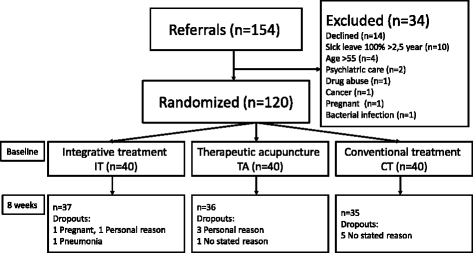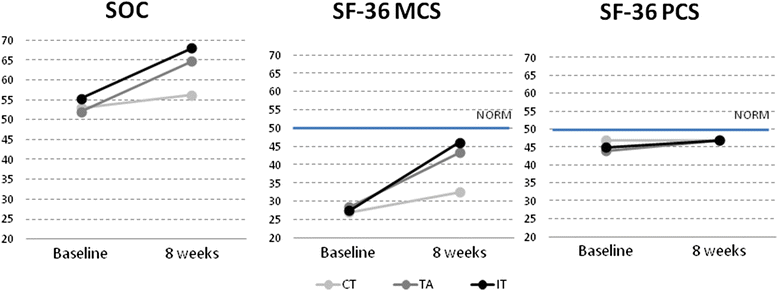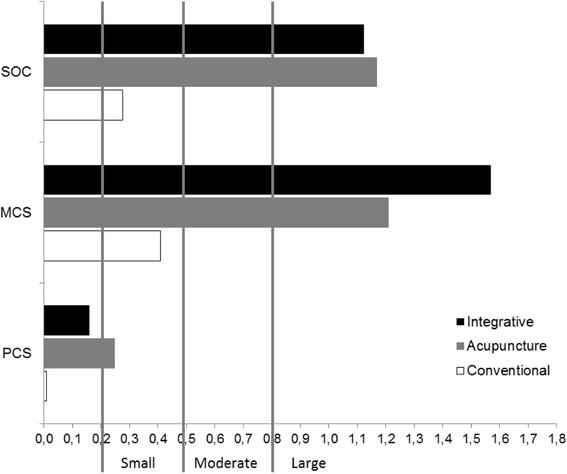Quality of life, sense of coherence and experiences with three different treatments in patients with psychological distress in primary care: a mixed-methods study
- PMID: 25928131
- PMCID: PMC4467206
- DOI: 10.1186/s12906-015-0654-z
Quality of life, sense of coherence and experiences with three different treatments in patients with psychological distress in primary care: a mixed-methods study
Abstract
Background: Psychological distress is associated with impaired health-related quality of life (HRQL) and poor sense of coherence (SOC). In a previous study, we found that therapeutic acupuncture (TA) and an integrative treatment that combined TA with person-centred approach in a salutogenic dialogue (IT) alleviated anxiety and depression significantly more than conventional treatment (CT) in primary care patients. Here, we report on secondary analyses regarding the HRQL and SOC from that previous pragmatic randomised controlled trial (RCT).
Method: Quantitative and qualitative design. One hundred twenty patients were referred for psychological distress. Quantitative analyses were performed at baseline and after 8 weeks of treatment using the SF-36 mental component summary (MCS), physical component summary (PCS) and the Sense of Coherence-13 (SOC) questionnaires. Qualitative manifest content analyses were based on open-ended questions-"Have you experienced any changes since the start of the treatment? Will you describe these changes?"
Results: No baseline differences were found. At 8 weeks, both the IT and TA groups had statistically better scores and greater improvement from baseline on the MCS and SOC than the CT group. The effect sizes were large. No significant differences were found between the IT and TA groups or in relation to the PCS. SOC was highly correlated with the MCS but not with the PCS. Dropout rates were low. The experiences of the intervention resulted in four categories: Being heading back; Status quo; Feeling confirmed; and Feeling abandoned, with 13 related subcategories.
Conclusion: IT and TA seem to improve sense of coherence and mental health status in primary care patients with psychological distress, whereas CT appears to be less beneficial. IT and TA appear to be well-accepted and may serve as useful adjunct treatment modalities to standard primary care. Our results are consistent with much of the previous research in highlighting a strong relationship between SOC and mental health status. The written qualitative data described feeling confirmed and feeling increased self-efficacy, self-care and faith in the future. Those in the CT group, however, described feeling abandoned, missing treatment and experiencing increased emotional and physical problems. More research is needed.
Trial registration: ISRCTN trial number NCT01631500.
Figures




References
-
- Doran DM. Psychological distress as a nurse-sensitive outcome. In Doran DM Nursing Outcomes The State of the Art. 2. Sudbury USA: Jones & Bartlett Learning; 2011.
-
- Drapeau A, Marchand A, Beaulieu-Prévost D. Epidemiology of Psychological Distress. In: LAbate PL, editor. Mental Illnesses - Understanding, Prediction and Control. Rijeka: InTech; 2012. pp. 155–134.
-
- Lazarus RS, Folkman S. Stress, appraisal, and coping. New York: Springer; 1984.
-
- World Organization of National Colleges, Academies, Academic Associations of General Practitioners/Family Physicians, World Health Organization . Integrating mental health into primary care: a global perspective. Geneva: World Health Organization; 2008.
Publication types
MeSH terms
Associated data
LinkOut - more resources
Full Text Sources
Other Literature Sources
Medical

